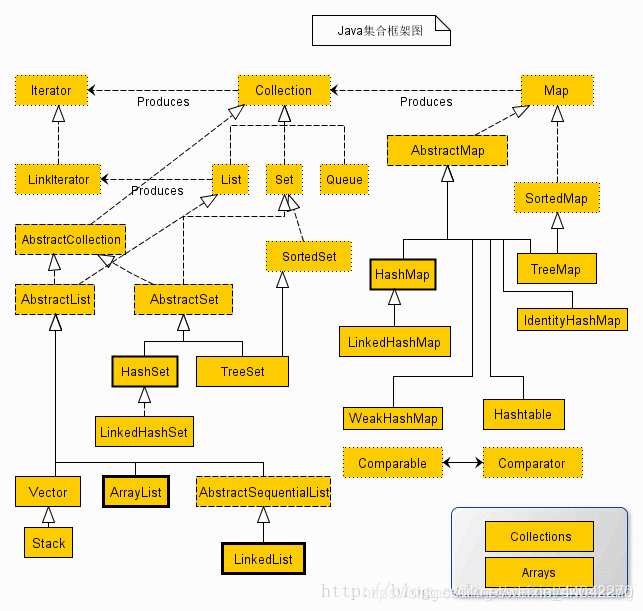4.1 枚举
1 | public class Demo{ |
4.1.1 枚举的实现
编译后内部实现的方式
1 | //继承java.lang.Enum并声明为final |
Java中枚举实际上是一个特殊的类,编译后会生成相对应的
.class文件Demo$Direction.class,是多例模式(Multiton)
4.1.2 匿名的内部类
1 | public class Demo{ |
WEST(10){ };在编译后会生成Demo$Direction$1.class,是Direction类的子类(匿名的内部类);同时也是Direction类的实例
4.2 Array
4.2.1 Overview
- Data structures consisting of related data items of the same type.
- Arrays are objects so they are reference type.
- Elements can be either primitive or reference types.
- Remain the same length once they are created.
- Variable-length arguments lists: can create methods are with varying numbers of arguments.
- Process command-line arguments in method main.
- Common array manipulations with static methods of class Arrays from the
java.utillpackage. - 数组本身是一个对象,其中也可以存放对象,object类是数组类的父类
- 一维数组中的元素存放在连续的存储空间中;多维数组的元素在内存中不连续
- Java:Jagged Array 锯齿状的数组,多维数组存放在非连续的内存中,因此
ints[0].length与ints[1].length可以不同 - C++:Rregular Array 整齐的数组,多维数组存放在连续的内存中,因此
ints[0].length与ints[1].length必须相同
- Java:Jagged Array 锯齿状的数组,多维数组存放在非连续的内存中,因此
- Java数组是一种引用数据类型。数组变量并不是数组本身,而是指向堆内存中存放的数组对象。因此,可以改变一个数组变量所引用的数组
1
2
3
4
5
6
7
8
9
10/*Object类是Array类的父类*/
public class Demo{
public static void main(String[] args){
int[] ints = new int[4];
System.out.println(ints.getClass().getSuperclass().get.Name());
}
}
//Output
java.lang.Object
4.2.2 数组的声明
1 | /*一维数组*/ |
- java数组是静态的,必须初始化后才可以使用,一旦初始化数组长度,长度是不可以改变的
- 动态初始化 & 静态初始化:
- 静态初始化:初始化时由程序员显式指定每个数组元素的初始值,由系统决定数组的长度
- 动态初始化:初始化时指定数组的长度,此时已经分配内存
1 | /*二维数组*/ |
4.3 Colletion

- 实线边框:实现类
- 折线边框:抽象类
- 点线边框:接口
具体内容参见:
集合继承关系图解
Java集合框架关系图
4.3.1 Overview
- Collection本身是一个接口(interface),不是一个类
- Collection中不可能存放基本数据类型:向ArrayList中放入100时,会先变为Integer类
- 底层实现的数据结构由程序员决定,可以通过数组实现,也可以通过链表实现
- 集合的大小并不确定
- Collection分为List,Set,Queue:
- List:元素之间有顺序,可以有重复项
- ArrayList:底层由数组实现
- LinkedList:底层由链表实现
- Set:元素之间没有顺序,不可以有重复项
- HashSet
- TreeSet
- Queue
- List:元素之间有顺序,可以有重复项
- Collection & Collections
- Collection:泛型的接口,接口中无法定义具体的方法(即带有方法体的方法),只能定义抽象方法;但在java1.8后可以在接口中定义具体的方法,无需在伴生类中定义
- Collections:工具类,是Collection的伴生类,其中全部为静态方法,不用创造对象
1 | interface I{ |
4.3.2 ArrayList
1 | import java.util.List; |
- 基于动态数组的一个List,底层用
Object[]来存储 - 其中封装了很多方法,如
add(),get()方法 - 特点:插入、删除元素很麻烦,但可以实现随机访问
4.3.3 LinkedList
- 基于链表的一个List
- 特点:插入、删除简便,但不能随机访问
4.3.4 HashSet
1 | import java.util.Set |
equals() & hashCode()
Set集合中不允许出现相同的项,Set集合在用Add()方法添加一个新项时,首先会调用equals(Object o)方法来比较新项与已有的某项是否相等,而不是用==来判断相等性。对于字符串等已重写equals()方法的类,是按值来比较其相等性的。
在set类型的集合中,如何判断元素是否重复呢,这就需要使用Object.equals()方法,但如果元素很多了,添加一个新元素时,比较的次数 就很多,例如已经有100个元素了,添加第101个元素时,就要和前面的元素比较100次,效率很低。
HashSet类用哈希算法作为搜索算法来存取对象,当向集合中加入一个新对象时,会调用对象的hashCode()方法得到对象的哈希码,从而判断两个对象是否相等,复杂度为O(1)。
哈希算法也称为散列算法,是将数据依据算法直接指定到一个地址上,
hashCode()实际上返回的是对象存储的物理地址。
Object类中定义了hashCode()和equals(Object o)方法,如果object1.equals(object2),那么说明这两个引用变量指向同一个对象,那么object1和object2的hashCode也一定相等。
调用set.add()时,先用hashCode()方法,再对哈希码相同的对象调用equals()方法
只用
equals()方法:效率低
只用hashCode()方法:不可靠
4.3.5 TreeSet
一、Comparable & Comparator
- Comparable
- Packaga
java.lang - Interface Comparable
- This ordering is referred to as the class’s natural ordering, and the class’s compareTo method is referred to as its natural comparison method.(自然排序算法)
int compareTo(T o):有this参数- Comparator
- Package
java.util - public interface Comparator
int compare(T o1, T o2):没有this参数- 所使用的Comparator可以是当前类的,也可以是其父类的(泛型编程)
List之间的区别:底层实现的数据结构不同
Set之间的区别:底层的数据结构以及搜索算法不同
二、构造函数
| Constructor | Description |
|---|---|
| TreeSet() | Constructs a new, empty tree set, sorted according to the natural ordering of its elements. |
| TreeSet (Collection<? extends E> c) | Constructs a new tree set containing the elements in the specified collection, sorted according to the natural ordering of its elements. |
| TreeSet (Comparator<? super E> comparator) | Constructs a new, empty tree set, sorted according to the specified comparator. |
| TreeSet (SortedSet |
Constructs a new tree set comtaining the same elements and using the same ordering as the specified sorted set. |
三、Brief Introduction
- 放入TreeSet的对象一定要能比较大小
- 同一类型及其子类型的对象可以放入一个TreeSet
- 默认采用自然排序(Comparable的
compareTo()方法) - 可以重写
compareTo()或new不同的Comparator
4.3.6 TreeMap & HashMap
public interface Map<K, V>
Map不属于Collection
Map中的一个key和一个value构成一个entrySet<Map.Entry<K, V>> entrySet()会产生一个set
- Map这个接口取代了Dictionary这个类
- TreeMap和HashMap的区别在于查找算法的不同
4.4 Array和Collection的区别
1 | import java.util.List; |
Array:covariant 协变的
Collection:invariant 不变的
(contravariant 逆变的)
- 为什么不把集合做成协变的?
- 集合中有类型擦除,所以若集合是协变的,则有可能add不属于该集合的对象进入
- 而数组没有类型擦除,所以在编译时便会报错
- Java泛型编程中可以利用一些机制达到协变的效果
1 | //协变返回:通过编译后产生的桥方法实现 |
4.5 Iterator
public interface Iterator
This interface is a member of the Java Collections Framework
- 循环遍历是通过Iterator来实现的,通过Iterable中的
iterator()方法获得迭代器 - 要使用Iterator必须要是iterable的